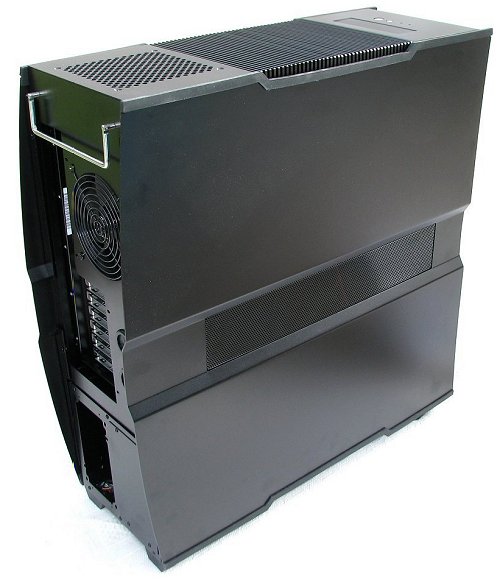External Design
The NZXT Khaos is a full ATX case, meaning it's quite large with dimensions 24.1" x 8.9" x 23.5", and a total weight of 34.6 lbs with nothing installed on it.
In comparison, the Thermaltake Armor+, one of my favorite full-sized ATX cases at the moment, shares similar dimensions at 23.6" x 9.6" x 24.6", while weighing slightly more at 37.0 lbs. While this may seem like an irrelevant comparison at this point, keep this information in mind as we will compare the two in better detail later.


The Armor+ is constructed from 1.0mm thick steel and includes a very large transparent plastic window. This case is only slightly heavier than the ultra-expensive, fully aluminum Khaos. This is because the Khaos is constructed from 2mm and 3mm thick aluminum, killing its overall weight.
NZXT has gone with thick aluminum to strengthen the case, making it more durable, with the trade-off of weight and of course, cost. This poses an interesting dilemma, as generally aluminum is used in cases to save weight at the cost of durability. Usually the trick plays out when manufacturers create a 1mm thick steel skeleton, which they then wrap in aluminum, adding a great deal of durability while remaining ultra light.


At the front of the Khaos there is a 3mm thick faceplate featuring two 120mm fan grills, along with five 5.25" drive bays, two of which are designed to house optical drives. Also, at the very top of the case there is a small silver NZXT label. Other than this, the face plate is quite bland looking and in my opinion doesn't exactly scream "insanely expensive case", but there you have it.

The right and left doors are identical in appearance, meaning both feature the same grill. The doors are all black and use rubber strips at the top and bottom to reduce vibration noises. To our surprise, the doors only slid into two clips (two at the top and two at the bottom), though this seemed adequate enough. Removing the left hand side door was a bit tricky at first, needing a little persuasion to come off.


At the top of the Khaos there are silver power and reset buttons which look nice enough, along with a green power and red hard drive status LED. Then there is a rectangle flap behind the power and reset button, which in all honesty looks a little cheap. Pushing on this flap reveals a small compartment where a number of I/O connectors are "hidden". In total there are two USB ports, a Firewire port and eSATA port, along with two audio jacks.
Moving further along there is a series of fins that look kind of like an amplifier you would find in the boot of your first car. These fins actually cover the entire top and bottom of the Khaos, though some are hidden by things like the power buttons and the I/O panel. There are more hidden fins on top of the case at the very back, where a 14cm fan lives. This is one of the few fans that come with the Khaos.

At the rear of the Khaos you will notice the case keeps the black color scheme which is nice. However, upsetting the black paint job is a funny little handle that could be practical despite looking rather cheap. Below the handle is a single rear mounted 120mm fan, which features a standard fan grill also painted black. Opposite to this fan is where the motherboard's I/O panel will be exposed to the rear of the case.

Further down we have space for seven expansion slots, which are accompanied by two 25mm holes designed to allow a water-cooling kit to exit the case and connect to an externally mounted radiator. Right at the bottom we get our first real surprise, as there are two brackets for standard ATX power supplies. This means the Khaos can be home to not one but two high-end power supplies, if ever needed. At the bottom of the case there is a pair of wheels mounted on front, and two aluminum feet at the rear.
